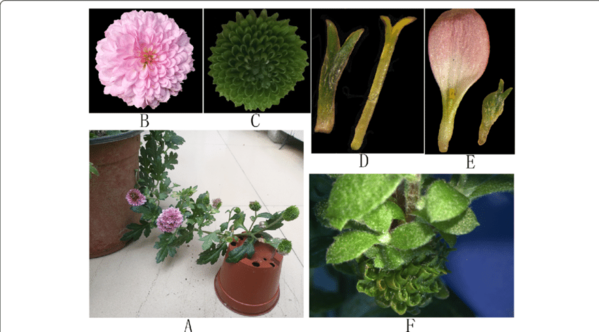Background Chrysanthemum morifolium is one of the most economically important and popular floricultural crops in the family Asteraceae. Chrysanthemum flowers vary considerably in terms of colors and shapes. However, the molecular mechanism controlling the development of chrysanthemum floral colors and shapes remains an enigma.
Experts analyzed a cut-flower chrysanthemum variety that produces normal capitula composed of ray florets with normally developed pistils and purple corollas and mutant capitula comprising ray florets with green corollas and vegetative buds instead of pistils. Results. They conducted a whole-transcriptome analysis of the differentially expressed genes (DEGs) in the mutant and normal capitula using third-generation and second-generation sequencing techniques. Besides, that identified the DEGs between the mutant and normal capitula to reveal important regulators underlying the differential development.
 Mutant Chrysanthemum morifolium 'ZY' plant. (a) Mutant and normal capitula. (b) Normal capitulum. (c) Mutant capitulum. (d) Vegetative buds in the mutant capitulum (left) and pistils in the normal capitulum (right). (e) Normal ray florets (left) and mutant ray florets (right). (F) New shoots from the mutant capitulum
Mutant Chrysanthemum morifolium 'ZY' plant. (a) Mutant and normal capitula. (b) Normal capitulum. (c) Mutant capitulum. (d) Vegetative buds in the mutant capitulum (left) and pistils in the normal capitulum (right). (e) Normal ray florets (left) and mutant ray florets (right). (F) New shoots from the mutant capitulum
Many transcription factors and genes related to the photoperiod and GA pathways, floral organ identity, and the anthocyanin biosynthesis pathway were differentially expressed between the normal and mutant capitula. A qualitative analysis of the pigments in the florets of normal and mutant capitula indicated anthocyanins were synthesized and accumulated in the florets of normal capitula, but not in the florets of mutant capitula. These results provide clues regarding the molecular basis of the replacement of Chrysanthemum morifolium ray florets with normally developed pistils and purple corollas with mutant ray florets with green corollas and vegetative buds. Additionally, the study findings will help to elucidate the molecular mechanisms underlying floral organ development and contribute to the development of techniques for studying the regulation of flower shape and color, which may enhance chrysanthemum breeding. Conclusions
The whole-transcriptome analysis of DEGs in mutant and normal C. morifolium capitula described herein indicates the anthocyanin deficiency of the mutant capitula may be related to the mutation that replaces ray floret pistils with vegetative buds. Moreover, pistils may be required for the anthocyanin biosynthesis in the corollas of chrysanthemum ray florets.
Read the complete research at: www.researchgate.net
Liu, Hua & Luo, Chang & Chen, Dongliang & Wang, Yaqin & Guo, Shuang & Chen, Xiaoxi & Bai, Jingyi & Li, Mingyuan & Huang, Xinlei & Cheng, Xi & Huang, Conglin. (2021). Whole-transcriptome analysis of differentially expressed genes in the mutant and normal capitula of Chrysanthemum morifolium. BMC Genomic Data. 22. 10.1186/s12863-021-00959-2.
